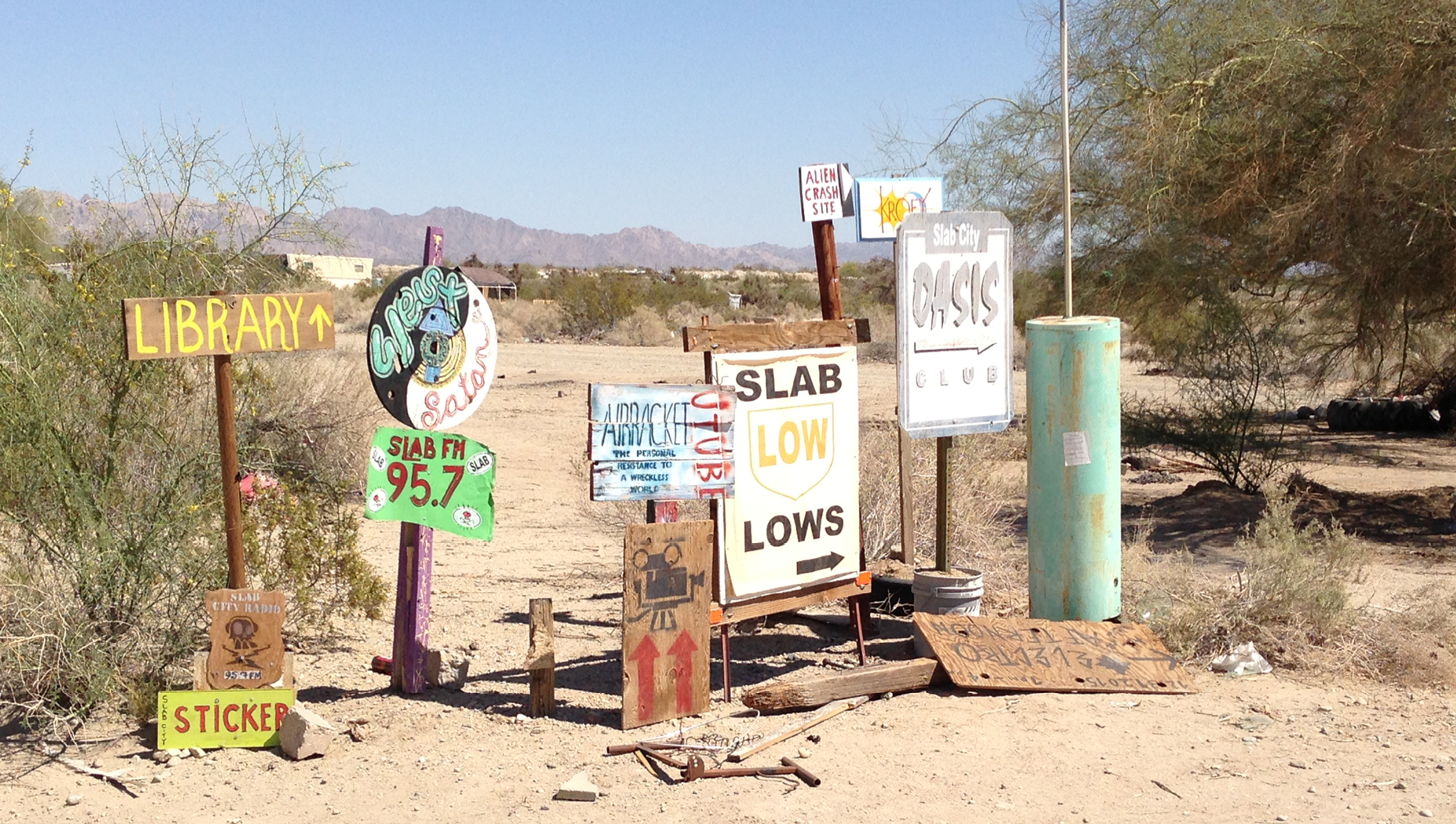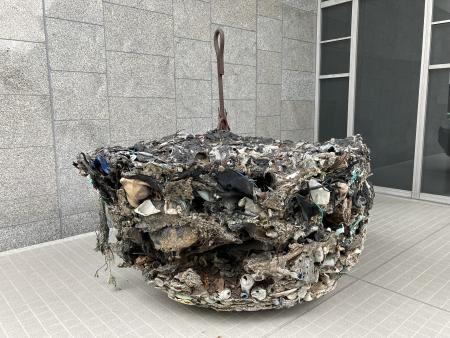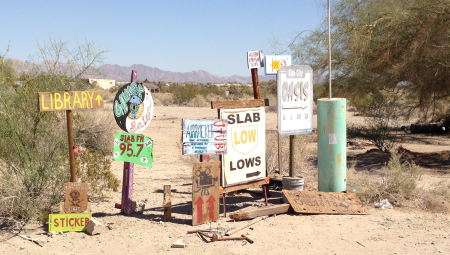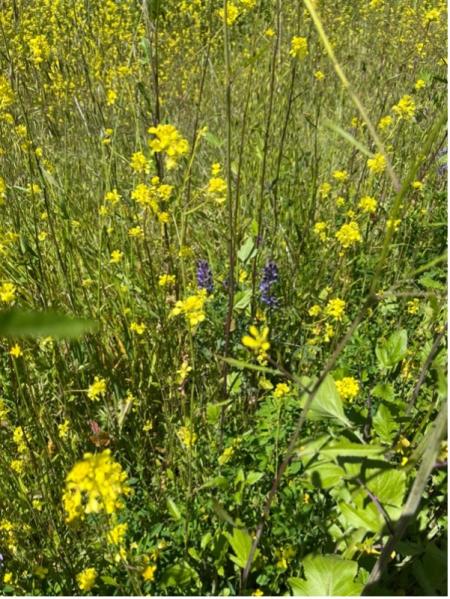
On the occasion of Earth Day’s 53rd birthday, we invited six scholars working in UCI’s School of the Humanities to contribute short reflections on the following provocation:
Imagining the future in 50 years–What would remaking the environment, or a remade environment, look like?
What follows are their responses, in words and images, that span from conspiring with plants to off-the-grid hyper-local communities to a memento mori of nuclear catastrophe.
Bert Winther-Tamaki, professor, art history

Over a hundred local volunteers spent an entire day in 1987 gathering trash covering the Niinohama Beach in Yamaguchi Prefecture in Japan and threw it into a large deep hole as part of a project by the environmental artist Tadashi Tonoshiki. Most of the trash was plastic washed ashore from the USSR, the Korean Peninsula, and China, and when the artist doused it with oil and set it on fire, the plastic melted and fused with soil from the sides of the hole. When cool, the two-ton agglomerate was hoisted out of the hole with a crane. With a wry sense of humor, Tonoshiki titled his trash sculpture Okonomiyaki, the name of a grilled fritter-like dish that is filled with variable ingredients and is especially popular in nearby Hiroshima.
The atomic bomb that was dropped on Hiroshima in 1945 when the artist was three years old killed his father immediately. His mother died of radiation sickness in 1950 and Tonoshiki himself suffered from radiation sickness as well, and would die a few years after creating Okonomiyaki. He said that burning and melting plastic trash gave him a sense of “confirming the unconscious memory of the scorched wasteland” he witnessed as a toddler. Following Tonoshiki’s wishes, the hulking carcass of plastiglomerate was left to weather and erode on the plaza of the Hiroshima City Contemporary Art Museum, but this fall we are going to transport it to the Mori Art Museum in Tokyo and install it on the fifty-second floor in front of a glass wall with a spectacular view of the glittering metropolis.
The long-range ballistic missiles fired periodically by North Korea over Japanese territory support the view that the Cold War never really ended in East Asia and now poses an increasingly ominous threat. Tonoshiki’s burnt plastic sculpture will serve as a memento mori warning against nuclear catastrophe that reduces the capital to a horrible wasteland like some enormous overcooked okonomiyaki.
Bert Winther-Tamaki is guest curator of an exhibition opening at the Mori Art Museum in Tokyo in October 2023.
Jamie Nisbet, associate professor and chair, art history
Living in Southern California, Earth Day each spring is a reminder of the connection between our local coastal environment and the ongoing struggle for its long-term sustainability. In the course of my own research on the history of California coastal practices and protections, I’ve been thinking recently about a bike ride that took place across the state in 1972 in support of a ballot initiative to create what is now the California Coastal Commission. The motivations for state representatives, everyday citizens, and even some children, to get on their bicycles that year are rooted in the same events that also spurred the complex combination of protests, teach-ins, and celebrations of the first Earth Day in 1970.
Both arose in direct response to a disastrous oil spill that had taken place off the coast of Santa Barbara the preceding year. It garnered mass national media coverage and the mobilized local groups like Get Oil Out! Prior to the Santa Barbara spill and the outpouring of public support for environmental causes on Earth Day, state legislators had repeatedly been unsuccessful in their attempts to get past the influence of oil industry lobbyists in creating laws to protect against the development and privatization of California’s coastal areas. Like Earth Day taking its message to the streets, Proposition 20 was crafted in 1972 to take coast protections directly to California voters. By September of that year, however, it looked like the same old story would be repeating itself: being heavily out funded by the petrodollars backing “No on 20,” the proposition’s prospects were lagging. That’s when a few young legislative staffers had the idea to stage the ride, which got picked up by local media coverage, and even a few celebrities along the way. As a do-it-yourself response to helping pass the California Coastal Act—which it ultimately achieved—the 1972 ride is a helpful reminder of the power of homegrown initiatives.
It also reminds us how much environmental imaginaries have shifted in the span of a few generations. For the dozens of cyclists, casting aside their cars, in protest of offshore drilling and urban development, there is no written record acknowledging the bicycles themselves as eco-friendly vehicles. The dominant petrochemical narrative has been inherited by our own era, and we continue to struggle against the forgetting of past moments when alternatives came into view.
Lyle Massey, associate professor, art history and visual studies
Off the grid | As homelessness increases and environmental stresses intensify in the United States (drought, water quality deterioration and rationing, landfill overflows, industrial hazards, air pollution, etc.), off-grid communities like Slab City near the Salton Sea will become models for habitation that defy urban norms. Residents of these communities will rely on solar and wind power and on shared bartering economies that stand outside of capitalist enterprises. They have their own libraries, bars and services. As macro-economic and political policies fail to address poverty or solve ecological problems such as climate change, temperature and sea-level increases, and rising demand for clean water and food resources, off-grid living will appear more and more attractive. Local communities will informally band together to solve immediate problems of energy and water access, becoming self-governing and less dependent on state and federal governmental assistance.

Many such communities already exist, particularly throughout the western US. Some are environmentally utopian in character (i.e. New Mexico’s Greater World Earthship Community), while others lean towards “prepper” (preparing for a breakdown in societal order and norms). But many also exhibit variations on do-it-yourself creativity, supporting musical groups, poetry and literature collectives, and multiple forms of visual art.
As with Noah Purifoy’s Desert Museum in Joshua Tree, these informal townships are often filled with installations of sculptures and structures built from trash and junk, presenting a running commentary on a contemporary culture that prizes constant consumption and planned obsolescence, producing waste at a breathtakingly rapid rate. In striking and startling ways, these communities show us where we are likely headed.
Judy Tzu-Chun Wu, associate dean, School of Humanities and director, Humanities Center and Center for Liberation, Anti-Racism, and Belonging
How is environmental justice a feminist issue? | Last year, coinciding with the 50th anniversary of Title IX, my co-authored biography of Patsy Takemoto Mink, Fierce and Fearless, was published by NYU Press. Mink was the first woman of color in Congress, first elected in 1964, and the namesake for Title IX, which mandates gender equity for schools receiving federal funding. Fewer people know, though, that in the late 1970s, she also served as assistant secretary of state under President Jimmy Carter for the Bureau of Oceans and International Environmental and Scientific Affairs (OES). Mink’s commitment to environmental protection and gender equity raises the question: How can environmental justice be a feminist issue?
As the head of OES, Mink’s purview literally encompassed the entire world. In fostering international agreements in the midst of the Cold War, Mink foregrounded a definition of environmentalism that included human welfare and human rights. As she explained in a speech to members of the Japanese American Citizens League in San Fernando Valley, “The whole concept of international environment . . . has been redefined…. Rather than presenting a ‘negative kind of concept of just preventing pollution,’ environment has been described as the total condition people find themselves in.”[i] In other words, environmentalism represented a way to advocate for human rights, conceptualized as “improving the quality of life, medical career, access to the benefits of technology.”[ii] These concerns regarding human welfare had economic, regional, and gendered impacts. In a speech given in Hawai‘i, Mink reminded her audience, “We know that at least one billion people still live in poverty or near poverty. Of the poor, women and children suffer the most.”[v] At another talk in Nairobi, Kenya, where Mink addressed the fifth meeting of the United Nations Environment Programme, she emphasized the importance of advancing “the human condition so that all peoples can share the bounty of the earth to enjoy good nutrition, safe water, and a healthful environment in which to live.”[vi]
As we celebrate Earth Day 53 years after its founding, I think it is important to consider the vision of Mink, who recognized the disproportionate impact of environmental injustice on particular communities. Her understanding of environmentalism did not seek solely to “protect” the environment from human beings. Instead, she foregrounded how the environment could sustain human life and enable women, particularly those who are impoverished and from the Global South, to fully thrive.
Jonathan Alexander, Chancellor’s Professor of English and Informatics and director, Humanities Core
I can’t imagine what the world will look like 50 years from now, and I’m hesitating to prognosticate — or even express a hope — because I’m not likely at all to be here at that point in the future. In fact, I have written elsewhere about the need to “deny legacy,” to unhitch ourselves from a sense that our lives should exceed their natural lifespans and that our thoughts, ideas, and feelings should live on after us, influencing the world to come, and, at worst, dictating terms about what we believe is important to the future.
Who are we to know what’s best for the future? Who are we to imagine that future when we have done so poorly imagining and building a survivable (much less sustainable) present?
In fact, maybe insisting on having a legacy is the problem, substantially contributing to impoverishing our world and its future. We insist on bequeathing our ideas, our way of life, insuring that our children will live as we have lived, if not better. We pass on wealth, for instance, and in the process we prolong structures of inequality, unleveling the “playing field” for all. We codify our values of acquisition and accumulation in law, protecting the ability of the haves to have more as opposed to practicing forms of wealth and resource redistribution now that will help those already suffering from climate, political, and economic crises.
So, instead of imagining a future, even a collective one, my instinct is to pull back, to make space for those who will actually inherit that future, for those who will live to see what 50 years from now will be like. To be sure, I’m here to help, but I don’t want to impose. More importantly, I’m here to listen. What do you want from your future? And how can I help you create the future that you will live to see?
Jon Pitt, assistant professor, East Asian Studies
I’m looking at the many yellow and purple flowers in bloom here in Southern California, and I’m struggling to imagine a “remade environment” fifty years in the future.

Something about the word “remake” suggests too clean a break. Something about the “make” in “remake” feels like it gives humans too much agency, as if “we” (who’s “we”?) could sculpt our environment differently, if only given the chance to try again. But whose future do we imagine when we imagine a future? How far do we stretch our “we”?
The flowers I’m looking at (some deemed “invasive” and targeted with removal) remind me of Natasha Myers’ “Ten (not-so-easy) steps for life in the Planthroposcene,”where she extends Tim Choy’s figuration of a “conspiracy of breathers” to plants. Myers stretches her “we” to plant life and implores us to do the same. She calls for us humans to “learn not just how to collaborate, but also how to conspire with the plants, to breathe with them. Remember, they breathed us into being.” In fifty-years’ time, can we humans learn to better con-spire (breathe with) and conspire (work together) with plant life—by far the most abundant form of life on this planet—in ways that encourage mutual flourishing? Meyers reminds us that “what is good for plants is good for everyone else. Get on their side.”
I choose to get on their side and imagine not a remade environment, but a world of remembering the fundamental codependence humans share with plant life. Fifty years is a long time for a human, but only the blink of an eye for some plants. A less-anthropocentric vision of the future finds humans collaborating with plant life on soil remediation, food stability, social/environment justice and land-back movements across the globe. An unruly, weedy future with deep roots and seeds spreading far and wide.
[i] “Mink: Everybody ‘Counts’ in Politics,” Pacific Citizen, February 17, 1978, p. 1.
[ii] “Patsy Takemoto-Mink Urges JAs to Shun Socializing for Activism,” Rafu Shimpo, February 9, 1978.
[iii] Patsy T. Mink, Note to Tom, October 6, 1977, Patsy Takemoto Mink Papers, Box 920, folder 4, Library of Congress Manuscript Division, Washington, D.C.
[iv] Mink, Note to Tom.
[v] Patsy T. Mink, “Speech at Federal Day Awards Luncheon,” June 24, 1977, p. 9, MP 924/10.
[vi] Patsy T. Mink, “Speech,” United Nations Environment Program, Nairobi, Kenya, May 11, 1977, MP 924/10.
[vii] Mink, “Speech,” United Nations Environment Program.
